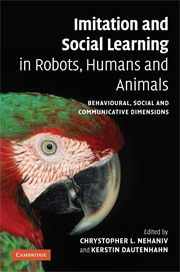 Imitation and Social Learning in Robots, Humans and Animals
Imitation and Social Learning in Robots, Humans and Animals Book contents
- Frontmatter
- Contents
- List of plates
- List of figures
- List of tables
- List of contributors
- Introduction: the constructive interdisciplinary viewpoint for understanding mechanisms and models of imitation and social learning
- Part I Correspondence problems and mechanisms
- Part II Mirroring and ‘mind-reading’
- Part III What to imitate?
- 7 The question of ‘what to imitate’: inferring goals and intentions from demonstrations
- 8 Learning of gestures by imitation in a humanoid robot
- 9 The dynamic emergence of categories through imitation
- Part IV Development and embodiment
- Part V Synchrony and turn-taking as communicative mechanisms
- Part VI Why imitate? – Motivations
- Part VII Social feedback
- Part VIII The ecological context
- Index
- Plate section
- References
9 - The dynamic emergence of categories through imitation
Published online by Cambridge University Press: 10 December 2009
- Frontmatter
- Contents
- List of plates
- List of figures
- List of tables
- List of contributors
- Introduction: the constructive interdisciplinary viewpoint for understanding mechanisms and models of imitation and social learning
- Part I Correspondence problems and mechanisms
- Part II Mirroring and ‘mind-reading’
- Part III What to imitate?
- 7 The question of ‘what to imitate’: inferring goals and intentions from demonstrations
- 8 Learning of gestures by imitation in a humanoid robot
- 9 The dynamic emergence of categories through imitation
- Part IV Development and embodiment
- Part V Synchrony and turn-taking as communicative mechanisms
- Part VI Why imitate? – Motivations
- Part VII Social feedback
- Part VIII The ecological context
- Index
- Plate section
- References
Summary
Introduction
Imitation is a powerful mechanism to culturally propagate and maintain knowledge and abilities. Not only humans rely heavily on imitation and social learning in general, but also animals such as dolphins, some bird species and some primates rely on imitation to acquire gestures and articulations (see e.g. Dautenhahn and Nehaniv, 2002b; Whiten and Ham, 1992). Studies on social learning in cognitive science have concentrated on mimicry, joint attention, the relationship between imitator and imitated, theory of mind, intentionality, speech (Kuhl and Meltzoff, 1996) and learning affordances of objects and tools (Tomasello, 1999). All these issues have been considered by artificial intelligence in constructing artefacts that learn from imitation, either in simulation (e.g. Alissandrakis et al., 2001) or on robotic platforms (e.g. Kuniyoshi et al., 1994; Gaussier et al., 1998; Billard and Hayes, 1997; Schaal, 1999). In this chapter however we wish to pay attention to the role of the social medium in which imitation takes place. Often, imitation is considered to take place only between two agents: one acts as teacher and the other as student. The teacher is in possession of a full repertoire of gestures, actions or articulations, which the student has to acquire through imitation learning. This is of course a valid approach when one is interested in the paradigm of imitation to program artefacts by demonstration (Bakker and Kuniyoshi, 1996).
- Type
- Chapter
- Information
- Imitation and Social Learning in Robots, Humans and AnimalsBehavioural, Social and Communicative Dimensions, pp. 179 - 194Publisher: Cambridge University PressPrint publication year: 2007
References
- 2
- Cited by


